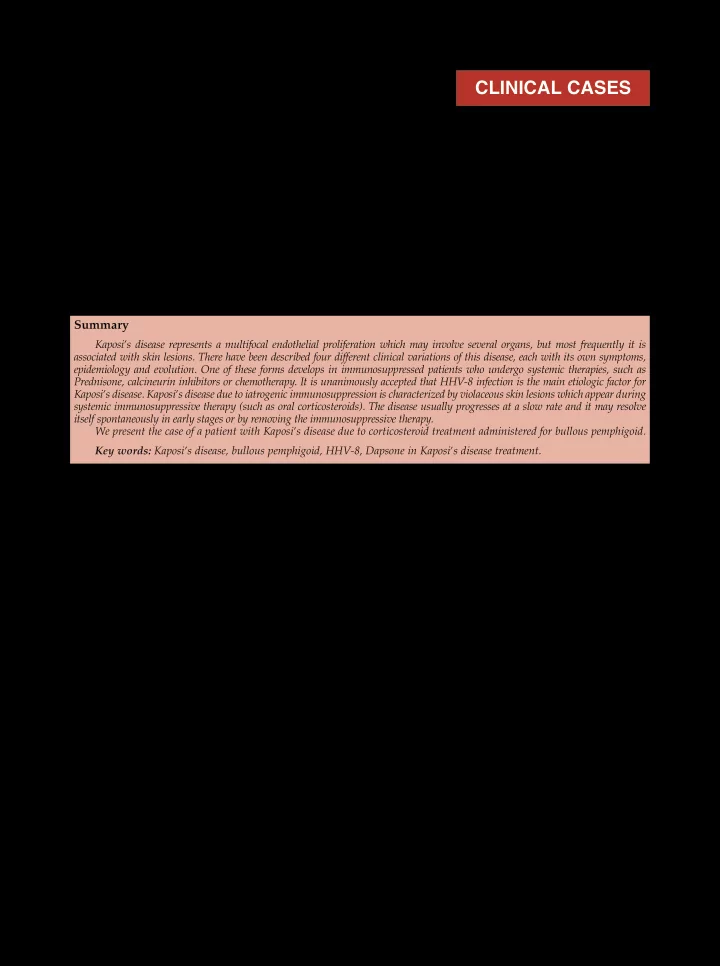

CLINICAL CASES BULLOUS PEMPHIGOID ASSOCIATED WITH IATROGENIC KAPOSI'S DISEASE - CASE PRESENTATION RALUCA-GABRIELA MIULESCU*, BOGDAN DIMA*, ANDREEA CÃLUGÃREANU*, VIRGINIA CHIÞU *,***, IRINA SALEM****, CÃLIN GIURCÃNEANU*,**, OLGUÞA-ANCA ORZAN*,** Summary Kaposi's disease represents a multifocal endothelial proliferation which may involve several organs, but most frequently it is associated with skin lesions. There have been described four different clinical variations of this disease, each with its own symptoms, epidemiology and evolution. One of these forms develops in immunosuppressed patients who undergo systemic therapies, such as Prednisone, calcineurin inhibitors or chemotherapy. It is unanimously accepted that HHV-8 infection is the main etiologic factor for Kaposi's disease. Kaposi's disease due to iatrogenic immunosuppression is characterized by violaceous skin lesions which appear during systemic immunosuppressive therapy (such as oral corticosteroids). The disease usually progresses at a slow rate and it may resolve itself spontaneously in early stages or by removing the immunosuppressive therapy. We present the case of a patient with Kaposi's disease due to corticosteroid treatment administered for bullous pemphigoid. Key words: Kaposi's disease, bullous pemphigoid, HHV-8, Dapsone in Kaposi's disease treatment. Received: 18.10.2017 Accepted: 24.11.2017 Introduction principal clinical variants of Kaposi’s disease: chronic; African endemic; epidemic, associated Kaposi’s disease, described for the first with HIV infection; iatrogenic, due to acquired time in 1872, represents a multifocal vascular immunosuppression (including systemic corti- proliferative process associated with HHV-8 cotherapy) [4,5]. infection [1,2]. The pathogenic pathway of this We present a case of iatrogenic Kaposi’s disease, triggered by the HHV-8 virus identified disease, secondary to immunosuppressive in all lesions, regardless of the clinical form, therapy administered for bullous pemphigoid. remains uncertain: first of all, it is unclear whether the lesions are caused by a reactive Clinical case vascular proliferation or by a neoplastic proliferation; secondly, it is still under debate A 77-year-old female patient, previously which type of endothelia – vascular or lymphatic diagnosed with bullous pemphigoid, for which – plays a more important role in pathogenesis she was administered systemic corticosteroids 0.5 [1,2,3]. In vitro studies have shown that HHV-8 mg/kg body weight/day with progressive can infect both the vascular and the lymphatic tapering over the course of several months, was endothelia, thus explaining the development of admitted into our clinic for exacerbated bullous inferior limb lymphedema which may be lesions and the development of erithemato- significant in some patients [2]. There are four violaceous nodules, 0.5 to 5 cm in diameter, with * Dermatology Department, “Elias” University Emergency Hospital, Bucharest, Romania. ** “Carol Davila” University of Medicine and Pharmacy, Bucharest, Romania. *** Dermatology Clinic 1, “Colentina” Clinical Hospital, Bucharest, Romania. **** Pathology Department, “Elias” University Emergency Hospital, Bucharest, Romania. 35
DermatoVenerol. (Buc.), 62: 35-38 Fig. 1. Erithemato-violaceous nodules, 0.5 to 2.5 cm in diameter, with well-defined margins, spread across the limbs; disseminated bullous lesions, in tension, with clear Fig. 2. Exacerbation of bullous lesions and appearance of contents, erosions and crusts erithemato-violaceous nodules Fig. 4. Spindle cells, arranged in fascicles, forming micronodules, with frequent extravasated erythrocytes and fine inlays of collagen strips; protrusive tumor cells in pre- existing vascular spaces; some blood vessels lacked their own walls (HE stain, 4X - a; HE, 10X - b) Fig. 3. Differently colored areas - blue, red, described as the Based on the patient’s history, the clinical "rainbow pattern", due to its resemblance to the rainbow color specter examination, the para-clinical investigations and the histopathology examination, we established well-defined margins, very itchy, spread across the diagnosis of Kaposi’s disease associated with the trunk and limbs. In addition, the patient also bullous pemphigoid. presented with right inferior limb lymphedema, The patient was initially administered several months old. (Fig. 1,2) Prednisone 0.8 mg/kg body weight/day, with a Dermoscopy of the violaceous nodules gradual decrease in dosage, up to 0.6 mg/kg revealed different colored areas – blue, red, body weight/day. In addition, we prescribed described as the “rainbow pattern”, due to its gastric protective agents and Dapsone 50 resemblance to the rainbow color specter [6,7]. mg/day. Topical treatment consisted of silver (Fig. 3) sulfadiazine. During the admission the patient’s We performed a punch-biopsy from the condition greatly improved. Therefore, we left forearm which was described by the decided to continue lowering the Prednisone pathology laboratory as: tumor fragment located dose by 0.15 mg/kg body weight/week until in the dermis, composed of spindle cells, cessation and replacement with Dapsone arranged in fascicles, forming micronodules, 50mg/day. with frequent extravasated erythrocytes and fine inlays of collagen fibers; protrusive tumor cells in Discussions and conclusions pre-existing vascular spaces; some blood vessels Patients undergoing systemic corti- lacked their own walls. Therefore, the result was cotherapy, chemotherapy or calcineurin inhibitor conclusive for the diagnosis of Kaposi’s disease treatment, may develop Kaposi’s disease. Of the [5]. (Fig. 4) immunosuppressive drugs, ciclosporin is most In order to rule out the epidemic variant of commonly involved, and a more rapid onset of Kaposi’s disease, we also tested the patient for HIV markers, which turned out negative. the disease is described. [2,3] 36
Recommend
More recommend